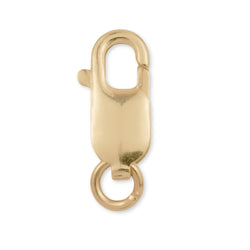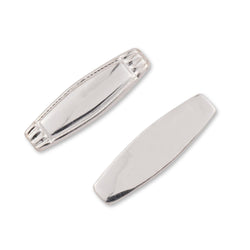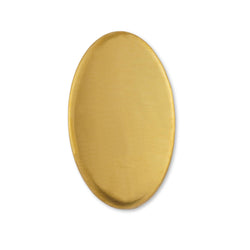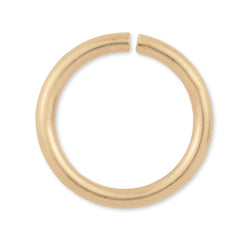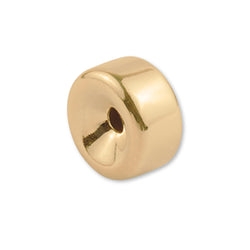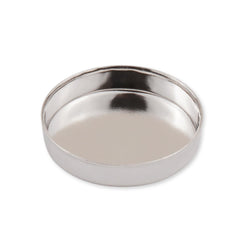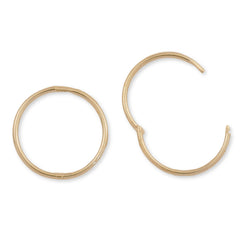Fynd
Det finaste inom smyckesfynd
Vår utvalda kollektion går utöver grunderna för att förbättra dina smyckesskapelser med precision och stil:
- Spännen och kopplingar : Säkra dina mönster med våra hållbara och snygga spännen och kopplingar. Hitta den perfekta matchningen för dina armband och halsband, från enkla hummerspännen till utsmyckade byglar.
- Örhängekomponenter : Förhöj dina örhängsdesigner med vårt urval av krokar, nitar och bågar. Tillverkade i högkvalitativa metaller garanterar de komfort och livslängd för din bärbara konst.
- Halsband och hängsmycken : Våra beslag erbjuder den perfekta utgångspunkten för dina halsband och hängen, vilket säkerställer att dina bitar hänger vackert och säkert.
- Allmänna resultat : Den här breda kategorin innehåller alla viktiga komponenter du behöver för dina smyckesprojekt, vilket ger dig byggstenarna för obegränsad kreativitet.
- Stämplingsämnen : Släpp lös din personliga touch med våra stämplingsämnen. Idealiska för anpassning, de är redo att präglas med dina unika mönster eller meddelanden.
- Hoppringar : Ett måste i alla smyckestillverkares kit, våra hoppringar finns i olika storlekar och finish, vilket säkerställer starka anslutningar i varje smycke du skapar.
- Beading & Stringing : Sträng dina pärlor med självförtroende med hjälp av våra överlägsna pärlmaterial, designade för styrka och flexibilitet.
- Korg- och raminställningar : Sätt dina stenar med precision med hjälp av vårt utbud av korg- och raminställningar, utformade för att visa upp dina pärlor med elegans.
- Berlocker : Lägg till personlighet och charm till dina skapelser med vårt utbud av dekorativa hängen, perfekta för armband, halsband och mer.
- Sömnörhängen : Våra örhängen är gjorda för komfort och dagligt slitage och ger en säker passform för dem som uppskattar subtil elegans.
Varje komponent i vår kollektion återspeglar vårt engagemang för kvalitet, och erbjuder dig de finaste guld- och silverlegeringarna att arbeta med. Dyk in i vårt utbud av smyckesfynd och välj de perfekta elementen för att komplettera din kreativa vision.
Vanliga frågor
Smyckesfynd är de väsentliga komponenterna som används för att montera och färdigställa smycken.
De inkluderar spännen, hoppringar, örhängen och kontakter – i princip all hårdvara som håller ihop smycken.
Dessa föremål är ryggraden i smyckestillverkning och ger både funktionalitet och estetisk tilltalande.
De finns i olika metaller som guld, silver och platina, och kan vara enkla i designen för praktiska ändamål eller dekorativa för att förstärka smyckets utseende.
Att använda smyckesfynd är grundläggande för hantverket att tillverka smycken.
Till att börja med, välj fynd som kompletterar din design i både stil och metalltyp. Till exempel, för att fästa ett hänge på ett halsband, skulle du använda en hoppring för att ansluta hänget till kedjan och ett spänne för att fästa halsbandet runt halsen.
Örhängekomponenter som krokar eller nitar är fästa på dina designade delar för att skapa bärbara örhängen.
Fynd som raminställningar används för att säkra ädelstenar i en bit.
Varje fynd har en specifik funktion och metod för applicering, som ofta kräver enkla verktyg som tång för att manipulera och säkra dem på plats.
Fördelarna med att använda smyckesfynd är många. De möjliggör en professionell finish, förvandlar lösa pärlor, ädelstenar och andra komponenter till bärbar konst.
Fynden ger den nödvändiga styrkan och hållbarheten för att säkerställa att smycken är funktionella och säkra. De erbjuder också mångsidig design, vilket gör att juvelerare kan skapa skräddarsydda smycken med en mängd olika förslutningar, kopplingar och dekorativa element.
Dessutom kan högkvalitativa fynd öka livslängden på smycken, minska slitage och se till att det förblir en uppskattad pjäs i många år framöver.
Jewellery findings are the small components used in the construction and assembly of jewellery pieces. These include items like clasps, earring backs, jump rings, and settings that are essential for attaching, securing, or adding functionality to a piece of jewellery. Findings are the building blocks of jewellery making, ensuring that your designs are both functional and aesthetically pleasing. Whether you're creating necklaces, bracelets, or earrings, high-quality findings are crucial for durability and appearance.
Choosing the right clasps and connectors depends on the type of jewellery you are creating and the materials you are using. For lightweight necklaces or bracelets, a simple lobster clasp might suffice. For heavier or more elaborate designs, consider using a padlock or toggle clasp for added security and style. Additionally, match the metal type and colour of the clasp with the rest of your design for a cohesive look. Always ensure that the clasp is strong enough to support the weight of the jewellery.
Earring components come in a wide variety, each serving a specific purpose to help you create diverse earring styles. Common components include:
Earring Backs: Essential for keeping earrings securely in place, earring backs come in various types like butterfly backs, screw backs, and push backs, each offering a different level of security and comfort.
Stud Settings: Stud settings are designed to securely hold gemstones and are ideal for showcasing their brilliance. These settings provide a classic look, making them perfect for minimalist designs where the focus is on the gemstone itself. The gemstone is typically set with prongs or a bezel, allowing light to enhance its natural beauty.
Pearl cup stud settings: Specifically designed for pearls or other round, smooth stones. These settings feature a shallow cup where the pearl is glued or attached securely. Unlike traditional stud settings, pearl cup settings are crafted to accommodate the unique shape and surface of pearls, providing a secure and elegant base that highlights the pearl’s lustrous appeal.
Ear Hooks: Versatile components often used in dangling earring designs, ear hooks allow for easy attachment of beads, charms, or other decorative elements.
Sleeper Earrings: Known for their comfort and suitability for everyday wear, sleeper earrings offer a secure fit and a subtle elegance. They also serve as a great base for adding charms, gemstones, or other dangle attachments.
Continental Clips: These clips offer extra security and are often used in more substantial or valuable earring designs. They are ideal for ensuring that larger or heavier earrings stay in place.
Earring Posts: A staple in earring making, posts are simple, straight components that are ideal for stud earrings. They can be paired with various backs and are typically used with gemstones or decorative fronts.
Ball Studs: Ball studs provide a clean, polished look and are often used as a base for more intricate designs. They can be worn alone for a minimalist style or paired with other components to create custom earrings.
Necklace and pendant fittings are used to securely attach pendants, charms, or other decorative elements to a chain or cord. These fittings include bails, end caps, and pendant settings that ensure your necklace hangs properly and stays in place. Bails are commonly used to attach pendants, while end caps provide a neat finish to beaded or strung necklaces. The right fittings enhance the overall look and functionality of your jewellery designs.
Recycled metals are important in jewellery making because they reduce the environmental impact of mining new materials. Using recycled silver, gold, and other metals helps conserve natural resources, reduces pollution, and supports sustainable practices in the jewellery industry. Additionally, recycled metals offer the same quality and durability as newly mined metals, making them a responsible choice for ethical jewellery makers and environmentally conscious consumers.
Stamping blanks are flat metal surfaces that can be customised with engravings, initials, dates, or designs using metal stamps. To personalise your jewellery, simply choose the appropriate blank, place it on a sturdy surface, and use metal stamps and a hammer to imprint your desired design. Stamping blanks are available in various shapes and sizes, making them perfect for creating unique, custom pieces like pendants, bracelets, and keychains.
Jump rings are small metal rings used to connect different components of a jewellery piece. They are essential for attaching clasps, charms, and pendants to chains, as well as linking other findings together. Jump rings are available in various sizes and finishes, and their strength and flexibility make them indispensable in both delicate and heavy-duty jewellery designs. Properly opening and closing jump rings ensures that your connections are secure and durable.
Selecting the best beading and stringing materials depends on the type of beads you're using and the overall design of your project. For lightweight beads, a fine beading thread or wire may be sufficient, while heavier beads may require a thicker, more durable stringing material like leather cord or nylon-coated wire. Consider the flexibility, strength, and colour of the material, and ensure it complements the beads and findings you are using.
Basket settings and bezel settings are both used to secure gemstones in jewellery, but they differ in design and appearance. A basket setting uses prongs to hold the gemstone, creating an open structure that allows more light to pass through the stone, enhancing its brilliance. A bezel setting, on the other hand, surrounds the gemstone with a metal rim, providing a secure and protective enclosure. Bezel settings offer a sleek, modern look and are ideal for active wear as they protect the edges of the gemstone.
Adding charms to your jewellery designs can be done effectively by using jump rings, split rings, or connectors. Choose charms that complement the overall theme of your design, and ensure they are proportionate to the size of the jewellery piece. Attach charms to bracelets, necklaces, or earrings using sturdy jump rings, ensuring they are securely closed. Charms can also be added to chain links or directly to clasps for a more personalised touch.
Sleeper earrings are small, simple hoops designed for comfort and everyday wear. They are often used as starter earrings for newly pierced ears because they are easy to sleep in, hence the name "sleeper earrings." Their lightweight and secure design make them popular for those who prefer minimalistic jewellery that can be worn continuously without irritation. Sleeper earrings are typically made from hypoallergenic materials like sterling silver or gold to prevent skin reactions.
The essential tools for working with jewellery findings are round-nose pliers, chain nose pliers and flat-nose pliers, with wire cutters, and a jeweller's file being helpful for fine tuning applications. Round-nose pliers are ideal for reaching into small gaps and manipulating most findings, such as jump rings, bails, and ear wires. Flat-nose pliers provide a strong grip, allowing you to hold and precisely manipulate small findings like clasps and connectors. Wire cutters are handy for trimming excess pearl cup mounting pegs, and cutting through various materials, while a jeweller's file is used to smooth out any rough edges, ensuring a polished finish.
For more specialised tasks, such as setting stones or stamping metal blanks, additional tools like bezel pushers, burnishers, or metal stamps may be required. These tools enable you to execute specific techniques with precision, expanding the range of designs and finishes you can achieve in your jewellery making.
Yes, gold findings are highly suitable for everyday wear in jewellery due to their durability, resistance to tarnish, and hypoallergenic properties. Gold findings, especially those made from solid 9ct or 18ct gold, retain their colour and finish over time, making them ideal for pieces that are worn frequently
To secure gemstones in basket settings, position the gemstone in the setting and gently press the prongs over the stone using a prong pusher or prong-setting pliers. Ensure each prong is evenly placed to hold the stone securely. For bezel settings, place the gemstone in the setting and use a bezel roller or burnisher to gently push the metal rim over the stone’s edge. The key is to apply even pressure around the stone to ensure it is held securely without damaging the gemstone.
When using headpins in jewellery making, start by sliding your beads or gemstones onto the headpin. Use round-nose pliers to create a small loop at the end of the headpin to secure the beads. Trim any excess wire with wire cutters. The loop can then be attached to other components, such as chains or ear hooks. Ensure the loop is closed securely to prevent the beads from slipping off. Headpins are ideal for creating dangles or connecting components in a variety of jewellery designs.
Yes, mixing sterling silver and gold findings in the same jewellery piece can create a stylish and modern look. This combination, known as mixed-metal jewellery, adds visual interest and versatility to your designs. When mixing metals, ensure that the overall design is balanced and that the metals complement each other. Using findings of similar quality and finish will help maintain a cohesive appearance.
Ethical jewellery findings are produced with a focus on sustainability, fair labour practices, and environmental responsibility. By using ethical findings, you support the ethical sourcing of materials, reduce the environmental impact of jewellery making, and align with consumer demand for responsibly made products. Ethical findings often include recycled metals, conflict-free gemstones, and components made under fair working conditions, making them an excellent choice for conscientious jewellers.
The most common types of clasps used in necklaces and bracelets include lobster clasps, parrot clasps and spring ring clasps. Lobster clasps are known for their durability and secure closure, making them a popular choice for necklaces and bracelets. Parrot clasps are convenient for those who prefer a quick and easy closure, while spring ring clasps are a classic choice for delicate chains.
Earring backs, also known as butterfly backs or scroll backs, are used to secure stud earrings in place. To ensure a secure fit, slide the earring post through your ear and then push the earring back onto the post until it feels snug. The back should be tight enough to keep the earring in place but not so tight that it causes discomfort. Always check that the earring back is made of a material that won't irritate your skin, such as hypoallergenic metals like sterling silver or gold.
Stud earrings feature a single post that goes through the earlobe and is secured with an earring back. They often showcase a gemstone, pearl, or simple metal design on the front. Sleeper earrings, on the other hand, are small, lightweight hoops designed for comfort and continuous wear, including during sleep. While studs are typically more decorative and can vary in size and complexity, sleeper earrings are minimalist and practical, ideal for new piercings or everyday wear.
Stamping blanks can be incorporated into custom jewellery designs by engraving them with initials, symbols, dates, or patterns to create personalised pieces. To use stamping blanks, place the blank on a solid surface, position your metal stamp on the desired area, and strike it firmly with a hammer. Stamping blanks are versatile and can be used in pendants, bracelets, keychains, and other jewellery items, allowing you to add a unique, custom touch to your designs.
For heavy-duty jewellery, it is recommended to use thicker gauge jump rings, such as 16-gauge or 18-gauge, which offer greater strength and durability. Closed jump rings or soldered jump rings provide extra security for high-stress areas, preventing them from opening under tension. Opt for jump rings made from sturdy materials like sterling silver or gold alloys to ensure that they can support the weight of the jewellery and withstand regular wear.
Connector charms are used to link different components in a jewellery design, such as connecting chains to clasps or adding decorative elements between beads. To use connector charms, attach them using jump rings or by threading them directly onto a chain or stringing material. Connector charms can also serve as focal points in a design, adding interest and personality to bracelets, necklaces, or earrings.
To choose the right size bezel cups for your gemstones, measure the diameter of your gemstone and select a bezel cup that matches or is slightly larger in diameter. The gemstone should fit snugly within the cup without excessive gaps, allowing the bezel to be pressed securely over the stone’s edges. Bezel cups are available in various sizes and shapes to accommodate different gemstones, ensuring a secure and aesthetically pleasing setting.
Lobster clasps and parrot clasps are both types of clasps used in jewellery making, but they differ in design and profile. A lobster clasp has a spring-loaded mechanism that opens and closes with a lever, resembling a lobster’s claw. It is known for its durability and secure closure, making it a popular choice for necklaces and bracelets.
A parrot clasp, while functioning with the same spring-loaded mechanism as a lobster clasp, features a slimmer and more angular profile, resembling the shape of a parrot. This design makes parrot clasps slightly more refined and elegant, often preferred for more delicate or finely crafted jewellery pieces. Both clasps offer secure fastening, but the choice between them typically depends on aesthetic preference and the specific design of the jewellery.
For minimalist jewellery designs, opt for simple and sleek findings such as small jump rings, delicate clasps, thin bezel settings, and subtle earring backs. Choose findings in high-quality materials like sterling silver or solid gold for a refined look. Minimalist designs often emphasise clean lines and understated elegance, so selecting unobtrusive findings that complement the overall design is key.
General findings, such as headpins, jump rings, clasps, and earring backs, are essential components that enhance your jewellery projects by providing structure, functionality, and aesthetic appeal. Use them to securely connect different elements, add movement to designs with dangling components, or provide a polished finish to pieces. High-quality findings ensure that your jewellery is not only beautiful but also durable and wearable.
To set pearls on pearl cup mountings securely, first apply a small amount of jewellery adhesive to the cup. Position the pearl on the cup and gently press it down, ensuring that it is centred and securely attached. Allow the adhesive to cure fully according to the manufacturer's instructions. For added security, some pearl cup mountings feature prongs that can be gently bent over the pearl to hold it in place.
Stud settings for gemstones come in various styles, including prong settings, bezel settings, and basket settings. Prong settings hold the gemstone with metal claws, allowing maximum light to enter the stone. Bezel settings surround the gemstone with a metal rim, offering a sleek and secure enclosure. Basket settings combine the features of prong and bezel settings, providing an open, supportive structure for the gemstone. Each type is suitable for different gemstones, depending on the desired look and level of security.
Enhancer pendants are designed with a hinged bail or clip that allows them to be easily attached to or removed from necklaces, chains, or pearls. To create versatile jewellery pieces, simply open the enhancer’s bail, slide it over the necklace or chain, and close the bail securely. Enhancers can be swapped between different necklaces, allowing you to customise your look effortlessly and create multiple styles with a single pendant.
End caps are small components used to finish the ends of chains, beaded strands, or cords in jewellery making. They provide a neat, polished finish and create a secure point for attaching clasps or other findings. End caps are generally soldered when working with metal chains to ensure a strong, durable connection. However, for leather, cord, and other mixed media applications, adhesive is typically used to secure the ends within the cap. To use end caps with these materials, apply a small amount of adhesive to the end of the strand, insert it into the cap, and allow the adhesive to dry. End caps are essential for creating professional-looking necklaces, bracelets, and multi-strand designs.
No, you are not legally required to use hallmark tags on jewellery in Australia. Unlike some other countries, such as the UK, where hallmarking is mandatory for certain precious metals, Australia does not have a legal requirement to hallmark jewellery. However, while it's not legally required, some jewellers may choose to use hallmark tags voluntarily as a way to indicate the quality and authenticity of their pieces. It's always a good practice to stay informed about industry standards and customer expectations, even in the absence of legal requirements.
Brooch fittings can be incorporated into custom jewellery designs by attaching them to the back of a decorative piece, such as a gemstone, enamel, or metalwork. Use soldering or adhesive to secure the fitting, ensuring it aligns properly for easy fastening. Brooch fittings typically include a pin and clasp mechanism that allows the brooch to be worn on clothing or accessories. Consider the weight and balance of the brooch when selecting the fitting to ensure comfort and durability.
Cufflink findings are the components used to create custom cufflinks, typically consisting of a front plate and a hinged back or post. To use them, attach your decorative element, such as a gemstone, enamel piece, or metal design, to the front plate using solder or adhesive. The hinged back allows the cufflink to be easily fastened to a shirt cuff. Cufflink findings are available in various materials and styles, allowing for the creation of personalised and sophisticated men’s jewellery.

